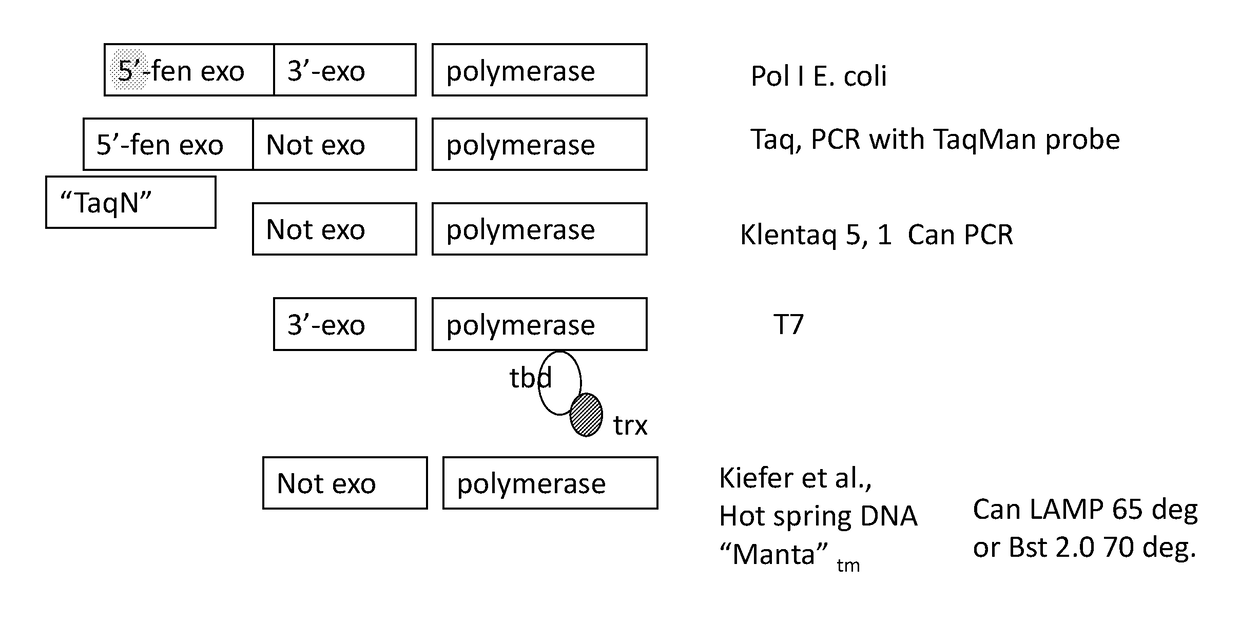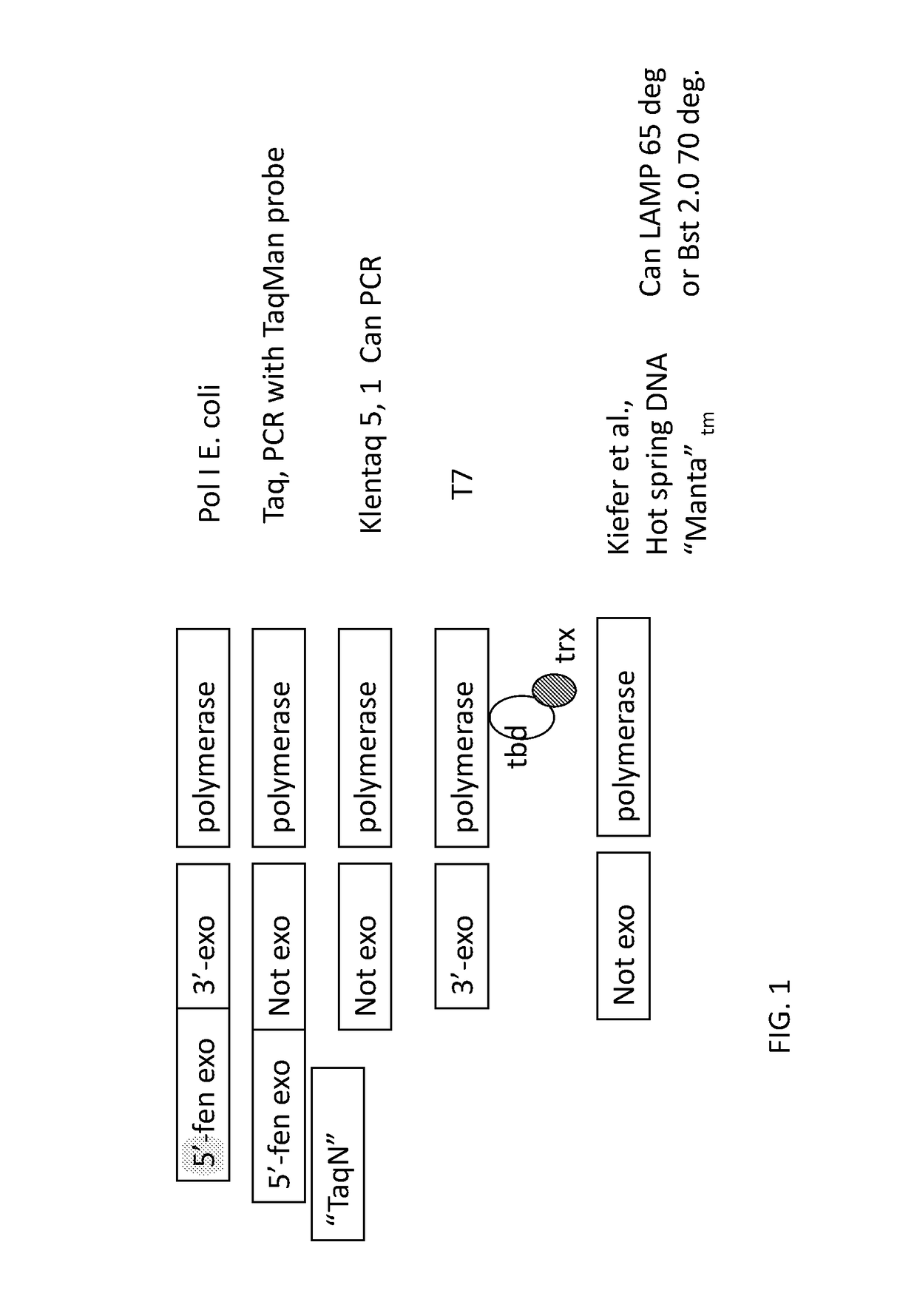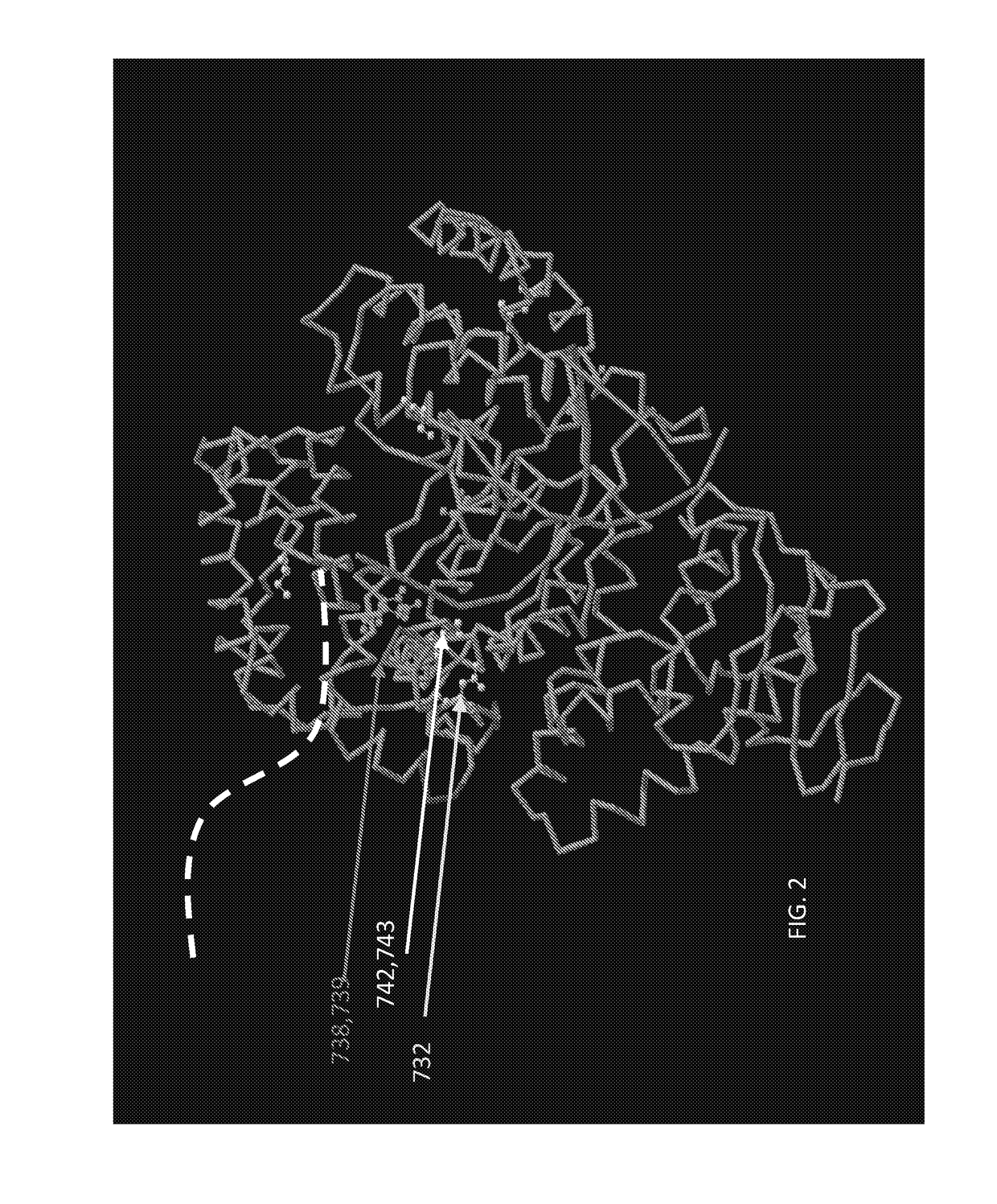Mutant polymerases and uses thereof
a technology of polymerases and polymerases, applied in the field of mutant polymerases, can solve the problems of unreliable, food safety assays, and limited food safety analysis for pcr and rt-pcr, and achieve the effect of improving performan
- Summary
- Abstract
- Description
- Claims
- Application Information
AI Technical Summary
Benefits of technology
Problems solved by technology
Method used
Image
Examples
example 1
[0174]This study showed the isolation of mutants resistant to inhibitors of food assays thus eliminating or decreasing the time and extent of these extraction procedures or improve the reliability of PCR assays of food. Total E. coli cells were used as a source of enzyme to screen circa 4,000 mutagenized clones that expressed Taq DNA polymerase from a plasmid. The screen used crude extract as the enzyme and template. Expression of 50 μl cultures in 96-well plates was induced, and PCR primers for endogenous ribosomal DNA (385 bp product) (forward TACAGACGTTTAAGCTTCGCAATTACC GGTT (SEQ ID NO: 11) and reverse AAAAAGCTGCAAATTGCGGTAGGTATTATT (SEQ ID NO: 12)), reaction buffer and SYBR Green were added as 35 μl directly to 3-5 μl of the bacterial culture, followed by immediate temperature cycling. Wild-type Taq or Klentaq1 clones give rise to robust PCR amplification under these conditions. When chocolate or cracked-pepper extract (3 μl of 10% w / v) was also included, PCR was suppressed for ...
example 2
[0180]Half-Dumbbell Construction.
[0181]A DNA “handle” was amplified from phage lambda DNA by PCR using primers 13.16 (GGCATTGTTTGGTAGGTGAGAGATCT (SEQ ID NO: 15)) and 13.17′ (ACAAATGACAAGAGTCTGGTTCAGAAGATA (SEQ ID NO: 16)), precipitated with PEG+SDS, and digested with HindIII and BgIII at its opposite ends. A stem loop consisting of self-annealed, 5′-phosphorylated DNA 11.164 (5P-agctCTGTCTCTTATACACATCTaataGTTTAACTTTAAGAAGGAGATATAaataAGATGT GTATAAGAGACAG (SEQ ID NO: 17)) was formed using T3 ligase (Enzymatics) in T4 ligase buffer (NEB) supplemented with 11 mM NaCl. This product was precipitated with PEG+SDS and resuspended in 1× Cutsmart buffer (NEB). To each 1.5 μg of DNA was added 1 μl T7 exonuclease (NEB) on and incubated on ice for 40 minutes to allow removal of ca. 50 bases from the 5′-BgIII end, followed by heat denaturation of the exonuclease at 75° C. for 15 min. In a buffer of TEN+200 mM NaCl, primer 13.16 was annealed to replace some of the bases removed by the T7 exonuclea...
example 3
[0191]The following example demonstrates strand displacement activity of full length mutant polymerase A111 (SEQ ID NO: 3). Methods are according to Example 2 unless otherwise described.
[0192]Mutant polymerase A111 (SEQ ID NO: 3) was originally identified as resistant to inhibitors of PCR assays of food (see U.S. Patent Application Publication No. 2014 / 0113299, published 24 Apr. 2014). From a mutagenized library, real-time PCR analysis identified enzyme variants that could still catalyze PCR in the presence of inhibitors. Clone A111 was identified from assays with cracked pepper inhibitor (see e.g., FIG. 6) and subsequent DNA sequencing (SEQ ID NO: 3) showed only a single change, D732N, from wild type Taq (SEQ ID NO: 1).
[0193]Strand-displacement activity (as in Bst polymerase) was attempted to be engineered into Klentaq1 (SEQ ID NO: 2) without compromising its thermostability, by swapping sections of these two aligned sequences, or by inserting a DNA binding domain between K738 and ...
PUM
| Property | Measurement | Unit |
|---|---|---|
| isothermal temperatures | aaaaa | aaaaa |
| pH | aaaaa | aaaaa |
| pH | aaaaa | aaaaa |
Abstract
Description
Claims
Application Information
 Login to View More
Login to View More - R&D
- Intellectual Property
- Life Sciences
- Materials
- Tech Scout
- Unparalleled Data Quality
- Higher Quality Content
- 60% Fewer Hallucinations
Browse by: Latest US Patents, China's latest patents, Technical Efficacy Thesaurus, Application Domain, Technology Topic, Popular Technical Reports.
© 2025 PatSnap. All rights reserved.Legal|Privacy policy|Modern Slavery Act Transparency Statement|Sitemap|About US| Contact US: help@patsnap.com



